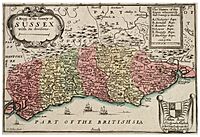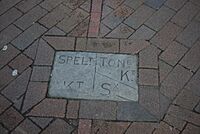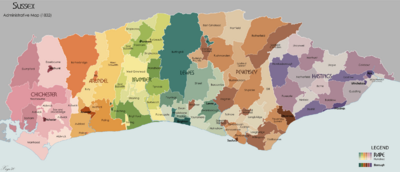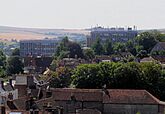History of local government in Sussex facts for kids
The history of local government in Sussex is a long and interesting story. Sussex started as a kingdom in the 400s. Later, in the 800s, it became part of the Kingdom of Wessex, which then grew into the Kingdom of England. Today, Sussex is split into two counties: East Sussex and West Sussex.
After a big change in law in 1832 (the Reform Act 1832), Sussex was divided into an eastern and a western part for managing local affairs. These divisions matched old church areas and county sections. In 1889, another law (the Local Government Act 1888) used these same boundaries to create two administrative counties: East Sussex and West Sussex. Also, two large towns, Brighton and Hastings, became self-governing "county boroughs," and Eastbourne joined them later.
In 1974, new changes happened with the Local Government Act 1972. Some areas in the middle of Sussex, like East Grinstead and Haywards Heath, moved from East Sussex to West Sussex. The Gatwick area, which used to be in Surrey, also moved to West Sussex. The county boroughs like Brighton and Hastings came back under the control of the county councils. However, in 1997, Brighton and Hove joined together to form a single local authority, and in 2000, Brighton and Hove became a city.
Even though Sussex is managed as two separate counties, many organizations still work across the whole area. These include Sussex Police, NHS Sussex (for health), and the Sussex Inshore Fisheries and Conservation Authority (for fishing). Sussex is also seen as one cultural area, important in its culture and sport.
Contents
- Saxon Times: Early Sussex Government
- Medieval Period: The Rapes Grow
- Early Modern Times: Dividing the County
- 1800s: New Towns and Divisions
- Local Government Districts 1894-1974: Further Changes
- 1974: Big Reforms
- 1990s: Further Changes
- 21st Century: Working Together
- Calls for Devolution: More Local Power
- Headquarters of Main Councils
- See also
Saxon Times: Early Sussex Government
Sussex began as its own kingdom in the 400s. In the 800s, it was taken over by the Kingdom of Wessex, which later became the Kingdom of England. When Sussex was independent, it probably had regular meetings called folkmoots, where people discussed important matters.
Sussex seemed to have more local control than other kingdoms. For a time in the 760s, there might have been four or five kings ruling different parts of the area. It's possible that the people of the Haestingas (around Hastings) had their own ruler for a while. Another division might have been along the River Adur.
At some point during the Saxon period, Sussex was divided into special areas called 'rapes'. These rapes might have been like the "shires" (counties) of the old Kingdom of Sussex. They even had their own sheriffs in the 1100s. Another idea is that the rapes came from the system of forts, or burhs (boroughs), built by King Alfred the Great in the late 800s to fight the Vikings.
Many local folkmoots (meetings) would have been held in Sussex. For example, at Ditchling, Tinhale, and Madehurst. The names Tinhale (meaning 'meeting-hill') and Madehurst (meaning 'assembly wooded hill') show where these early meetings took place. There was also a place in Durrington called gemot biorh, which meant a meeting mound.
Early "hundreds" (smaller administrative areas) often met outdoors in a central spot, perhaps by a tree, like at Easebourne. From the 900s onwards, the hundred became important for justice and local management. The meeting place was often a landmark, like a bridge or a special tree.
Medieval Period: The Rapes Grow
When the Normans conquered England in 1066, Sussex had four rapes: Arundel, Lewes, Pevensey, and Hastings. By the time of the Domesday Book (a great survey of England), William the Conqueror had created the Rape of Bramber. He took parts from Arundel and Lewes rapes to do this, so the Adur river mouth could be better protected. Between 1250 and 1262, the Rape of Chichester was created from the western half of Arundel rape. From then on, Sussex was divided into six rapes from west to east: Chichester, Arundel, Bramber, Lewes, Pevensey, and Hastings.
We don't know exactly why the rapes were first created, but after 1066, their job was clear. Each rape had its own lord and sheriff, and it was a unit for managing the area and collecting taxes.
Early Modern Times: Dividing the County

Managing a large county like Sussex as one unit was hard. The main court meetings, called "quarter sessions," were held in Chichester in the southwest. This was a long way for many people in the county to travel. By the 1590s, all local arrangements respected the division of Sussex into an eastern part and a western part. The eastern part included the rapes of Hastings, Lewes, and Pevensey. The western part included the rapes of Arundel, Bramber, and Chichester.
Sussex had seven quarter sessions instead of the usual four. During certain weeks, one court met in western Sussex on Mondays and Tuesdays, and another met in eastern Sussex on Thursdays and Fridays. The western meetings moved between Chichester, Petworth, Arundel, and Midhurst. The eastern meetings always took place at Lewes. The midsummer meeting for all of Sussex was held at East Grinstead or Horsham. By the time of Queen Elizabeth I, the eastern and western quarter sessions were almost completely separate. The only link between them was the Clerk of the Peace (a legal officer).
The courts for the rapes continued to meet, and their managers (called stewards) were recorded until the 1700s.
1800s: New Towns and Divisions
By 1835, many Sussex towns had "borough" status. A new law, the Municipal Corporations Act 1835, created a standard system for these "municipal boroughs." In Sussex, towns like Arundel, Chichester, Hastings, and Rye became municipal boroughs in 1836. Brighton followed in 1854, and Lewes in 1881. Some older boroughs, like Midhurst and Pevensey, lost their borough status in 1886 because they hadn't updated their local government. New municipal boroughs were created later for Eastbourne (1883), Worthing (1890), Hove (1898), and Bexhill (1902).
Between 1834 and 1930, "poor law unions" were set up to help people who were poor. In 1860, the northern part of Frant parish became part of the Tunbridge Wells Local Government District.
Sussex, like some other counties, was officially divided into an eastern and a western part for administrative purposes by the County of Sussex Act 1865. This had been an informal arrangement for centuries. In 1889, "county councils" were created for these eastern and western divisions. Large towns like Brighton and Hastings became "county boroughs," meaning they managed themselves. The western division included the rapes of Arundel, Bramber, and Chichester. The eastern division included the rapes of Lewes, Pevensey, and Hastings. Sussex was still considered one county under the law, keeping a single Lord Lieutenant and Sheriff.
In 1894 and 1895, small changes were made to the border between Sussex and Kent. The parish of Frant, which was in both counties, was split. Parts of it in Kent became new parishes. Also, in 1895, part of Lamberhurst moved to Kent, while parts of Horsemonden and Broomhill from Kent moved to Sussex.
The rest of each administrative county, not including the county boroughs or municipal boroughs, was divided into "urban" (town) and "rural" (countryside) districts by the Local Government Act 1894. A new county borough for Eastbourne was created in 1911.
Local Government Districts 1894-1974: Further Changes
The local government districts created in 1894 stayed mostly the same until the 1930s. New laws in 1929 and 1933 allowed county councils to review and combine smaller districts to create more effective council areas. Changes were made in West Sussex in 1933 and in East Sussex in 1934. Many smaller districts were combined into larger ones to make local government more efficient. For example, in East Sussex, Battle Rural District absorbed several other districts. In West Sussex, new districts like Chanctonbury Rural District were formed from parts of older ones.
1974: Big Reforms
Local government in England was changed a lot in 1974 by the Local Government Act 1972. Under this law, the old administrative counties and county boroughs were ended. The area of Sussex was divided into new non-metropolitan counties:
- East Sussex now included the former county boroughs of Brighton, Eastbourne, and Hastings. It also included municipal boroughs like Bexhill, Lewes, and Rye, along with various urban and rural districts from the old East Sussex.
- West Sussex now included municipal boroughs like Arundel, Chichester, and Worthing, along with urban and rural districts from the old West Sussex. Importantly, areas like Burgess Hill and Cuckfield rural district were moved from East Sussex to West Sussex.
The towns of Brighton, Eastbourne, and Hastings, which were once self-governing county boroughs, became boroughs within the new non-metropolitan county of East Sussex.
The urban districts of Burgess Hill, Cuckfield, and East Grinstead, and most of Cuckfield Rural District, were moved to the new district of Mid Sussex. These areas were transferred from East Sussex to West Sussex. This change aimed to bring areas affected by the growing economy of Crawley and Gatwick Airport under one local authority. There was some protest about these changes at the time.
The Royal Mail also started using East and West Sussex as postal counties in 1974, though postal counties are no longer officially used.
1990s: Further Changes
A review of local government in the 1990s led to more changes. Brighton got its unitary status back in 1997 by joining with the borough of Hove to form Brighton and Hove. This meant they managed all local services themselves, rather than sharing with the county council. Brighton and Hove then became a city in 2001.
21st Century: Working Together
In the 2000s, there has been more cooperation between neighboring local authorities. For example, Adur District Council and Worthing Borough Council have been working under a single management structure since 2008. There have also been proposals for wider sharing between Eastbourne and Lewes councils.
In 2020, East Sussex and West Sussex County Councils started sharing the same chief executive, showing a move towards closer working.
Calls for Devolution: More Local Power
Some people believe that the current division of Sussex into east and west is "unnatural." They have called for East and West Sussex to be reunited. Others have suggested that Sussex should have its own devolved regional assembly, similar to the Welsh Senedd, with powers to raise taxes.
In 2015, two proposals for more local power (devolution) involving Sussex councils were sent to the UK Government. One idea involved East and West Sussex County Councils working with Surrey County Council. Another proposal involved the city of Brighton and Hove, along with Adur, Lewes, Mid Sussex, and Worthing, who had already agreed on a "Greater Brighton City Deal" in 2014.
Headquarters of Main Councils
See also







